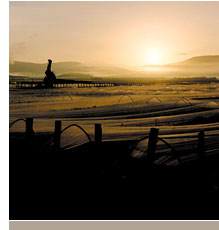
Jump to:
What is Geothermal Energy? An overview
How does Harnessing Geothermal Energy Work?
U.S. Geothermal Energy Potential
Applications of Geothermal Energy
Costs of Geothermal Energy
Other Benefits of Geothermal Energy
Works Cited

The term geothermal comes from the Greek geo meaning earth and therine meaning heat thus geothermal energy is energy derived from the natural heat of the earth. The heat that flows from the Earth's hot interior due to crustal plate movements, zones of high heat flow, may be located close to the surface where convective circulation plays a signifcant role in bringing the heat close to the surface (World Bank Group, 2004).
 The Earth's crust,
on which we live and depend, is in large part the product of
millions of once-active volcanoes and tremendous volumes of magma that
did not erupt but instead cooled below the surface. Such
persistent and widespread volcanism has resulted in many valuable
natural
resources throughout the world. ...
Groundwater heated by
large, still-hot magma bodies can be tapped for geothermal energy.
-- Excerpt from:
Brantley, 1994, Volcanoes of the United States, USGS General
Interest Publication
The Earth's crust,
on which we live and depend, is in large part the product of
millions of once-active volcanoes and tremendous volumes of magma that
did not erupt but instead cooled below the surface. Such
persistent and widespread volcanism has resulted in many valuable
natural
resources throughout the world. ...
Groundwater heated by
large, still-hot magma bodies can be tapped for geothermal energy.
-- Excerpt from:
Brantley, 1994, Volcanoes of the United States, USGS General
Interest Publication
Deep circulation of groundwater along fracture zones will bring heat to shallower levels, collecting the heat flow from a broad area and concentrating it into shallow reservoirs or discharging as hot springs. These reservoirs may contain hot water and/or stream. By drilling into these reservoirs, the hot water and/or steam is piped to the surface where it is used for direct use applications, or the high pressure steam is separated to drive turbines for power generation. The low energy waste water form such power generaiton is then usually re-injected back into the reservoir, or further utilised for direct heat applications. This technology enables it to be utilised to generate electricity and provide domestic and industrial heat. Geothermal energy has proven to be reliable, economic, environmentally friendly and renewable (World Bank Group, 2004).
In general
there are two main categories, (1)
the high temperature resources and (2)
the moderate/low temperature resources. The high temperature geothermal
resources - 220 degrees Celsius and up - are predominantly found in
volcanic regions and island chains. The moderate to low temperature
resources are found on all continents. The high temperature are almost
always used for power production while most of the low temperature
resources are used for direct heating purposes or agriculture and
aquaculture.
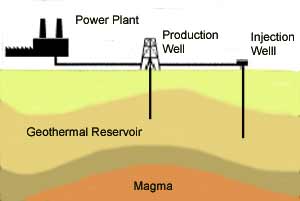
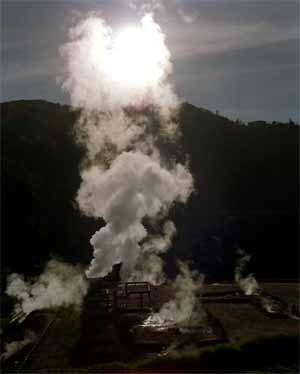
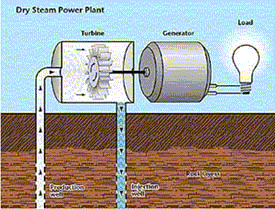 Dry Steam
Plants
which use geothermal steam directly. Dry steam power plants use very
hot (>455 °F, or >235 °C) steam
and little water from the geothermal reservoir. The steam
goes directly through a pipe to a turbine to spin a generator that
produces electricity. This type of geothermal power plant is the
oldest, first being used at Lardarello, Italy, in 1904. An example of a dry
steam generation operation is at the Geysers in North California, shown
at right
(Green Jobs, 2002).
Dry Steam
Plants
which use geothermal steam directly. Dry steam power plants use very
hot (>455 °F, or >235 °C) steam
and little water from the geothermal reservoir. The steam
goes directly through a pipe to a turbine to spin a generator that
produces electricity. This type of geothermal power plant is the
oldest, first being used at Lardarello, Italy, in 1904. An example of a dry
steam generation operation is at the Geysers in North California, shown
at right
(Green Jobs, 2002).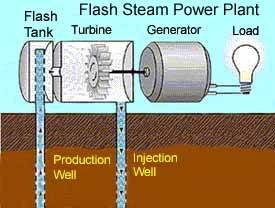
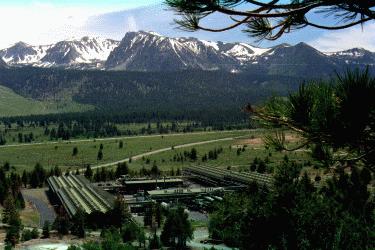
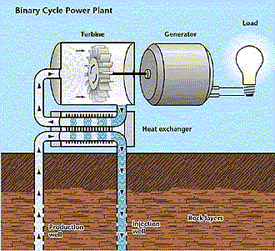 Binary Cycle Plants
which use moderate-temperature water (225 to 360 ºF, or 107 to 182
ºC) from the geothermal reservoir. In binary systems, hot
geothermal fluids are passed through one side of a heat exchanger to
heat a working fluid in a separate adjacent pipe. The working fluid,
usually an organic compound with a low boiling point such as Iso-butane
or Iso-pentane, is vaporized and passed through a turbine to generate
electricity. An ammonia-water working fluid is also used in what is
known as the Kalina Cycle. Makers claim that the Kalina Cycle system
boosts geothermal plant efficiency by 20-40% and reduces plant
construction costs by 20-30%, thereby lowering the cost of geothermal
power generation (Green Jobs, 2002). The Mammoth Pacific binary
geothermal power plant, located at the Casa Diablo geothermal field, is
pictured at right (Idaho National Engineering and Environmental
Laboratory, 2004).
Binary Cycle Plants
which use moderate-temperature water (225 to 360 ºF, or 107 to 182
ºC) from the geothermal reservoir. In binary systems, hot
geothermal fluids are passed through one side of a heat exchanger to
heat a working fluid in a separate adjacent pipe. The working fluid,
usually an organic compound with a low boiling point such as Iso-butane
or Iso-pentane, is vaporized and passed through a turbine to generate
electricity. An ammonia-water working fluid is also used in what is
known as the Kalina Cycle. Makers claim that the Kalina Cycle system
boosts geothermal plant efficiency by 20-40% and reduces plant
construction costs by 20-30%, thereby lowering the cost of geothermal
power generation (Green Jobs, 2002). The Mammoth Pacific binary
geothermal power plant, located at the Casa Diablo geothermal field, is
pictured at right (Idaho National Engineering and Environmental
Laboratory, 2004).
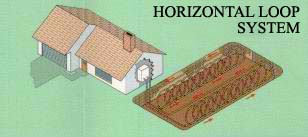
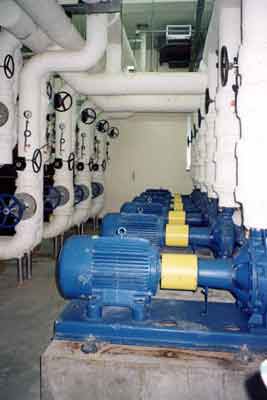 There is also
another method, called
geothermal heat pumps. The
earth’s surface layer remains at an almost constant temperature between
10 to 16C (50 to 50F). In this method, geothermal heat pumps use a
system of buried
pipes linked to a heat exchanger and ductwork into buildings. In winter
the relatively warm earth transfers heat into the buildings and in
summer the buildings transfer heat to the ground or uses some of it to
heat water. These heat pumps function as both air-conditioning and
heating systems in one (Green Jobs, 2002)
There is also
another method, called
geothermal heat pumps. The
earth’s surface layer remains at an almost constant temperature between
10 to 16C (50 to 50F). In this method, geothermal heat pumps use a
system of buried
pipes linked to a heat exchanger and ductwork into buildings. In winter
the relatively warm earth transfers heat into the buildings and in
summer the buildings transfer heat to the ground or uses some of it to
heat water. These heat pumps function as both air-conditioning and
heating systems in one (Green Jobs, 2002)

In 1999, geothermal energy provided 0.4%
of
U.S. electricity generation (14.3 billion kWh), enough to supply
electricity to over 1,400,000 average
U.S. homes. U.S. geothermal
capacity grew only slightly from 1990 to 1998, by 2.7% from 2,775 MW to
2,850 MW. Worldwide, geothermal capacity in 1999 was 8.24 million kW,
or 0.26% of the 3,180 million kW of total world installed electrical
generating capacity. Worldwide geothermal capacity grew much more
rapidly than the U.S. over the last decade, by over 40% from 5,867 MW
in 1990 to 8,240 MW in 1998. However, the United States still accounted
for 35% of worldwide installed geothermal capacity in 1998 (Geothermal
Education Office, 2003).
Puna Geothermal, the only geothermal power plant in Hawaii, can
generate a net of 25 MW of electrical energy (or 24% of Hawaii's
electrical energy) from the geothermal fluids produced from the Puna
geothermal field (USGS, 2004).
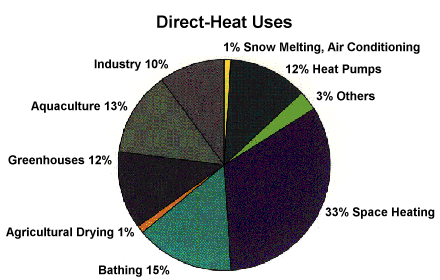 1.
Space/District Heating: Schemes utilizing
geothermal heat
provide over 80% of the central heating needs of Reykjavik city in
Iceland and are employed in many towns in USA, Poland and Hungary. The
World Bank is currently supporting a program in Poland for using hot
water from unsuccessful oil wells to displace the use of coal for
district heating (World Bank Group, 2004).
1.
Space/District Heating: Schemes utilizing
geothermal heat
provide over 80% of the central heating needs of Reykjavik city in
Iceland and are employed in many towns in USA, Poland and Hungary. The
World Bank is currently supporting a program in Poland for using hot
water from unsuccessful oil wells to displace the use of coal for
district heating (World Bank Group, 2004).
2.
Agriculture and Aquaculture: In temperate and
colder climates, greatly improved plant and fish growth can be achieved
by heating soils, greenhouses and fish ponds using geothermal heat. One
example of this is the largely successful Osearian Farm, Kenya (World
Flowers, 2005).
3. Power
Generation: With over 8000 MW
of installed
capacity, geothermal electric power generation is a well-proven
technology that has been especially successful in countries and islands
that have a high reliance on imported fossil fuels (World Bank Group,
2004).
Although
geothermal energy has been around for over a century, we are just now
realizing its potential for replacing and/or supplementing current
energy resources. In the U.S., most geothermal sources are in the
western states, including Alaska and Hawaii. This limited usage
seems to be geothermal energy's greatest downfall, despite being clean,
efficient, and cheap. When compared to other alternative
energies, such as solar, geothermal energy only outputs a small
fraction of that of solar energy dispersed atop the earth's
surface. We should consider its margin for improvement.
Although geothermal energy units can be expanded as needed, its methods
and its technologies have been virtually stagnant. Also, as we
explore alternative energy sources, we should consider its
appropriateness for various points on the globe.
